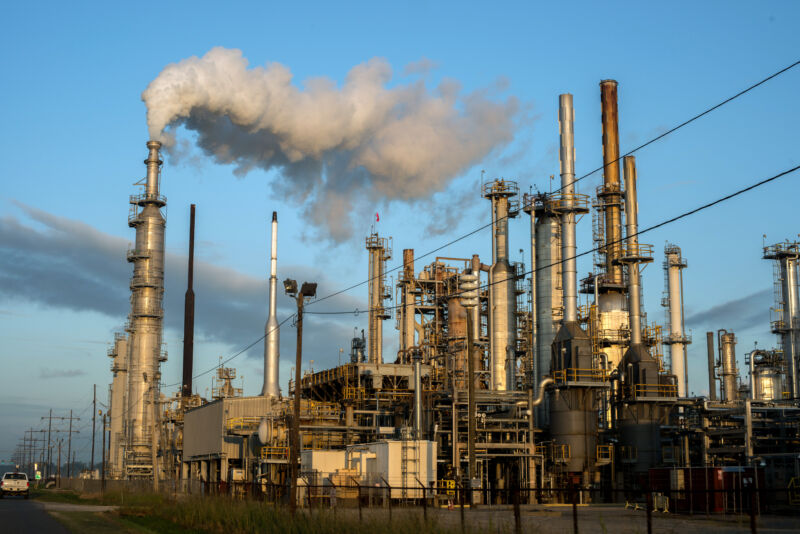Mo plastic mo problems —
Supply chain for plastic production is rife with carbon emissions.
Tim De Chant
–

Enlarge / Smoke billows from one of many chemical plants near Baton Rouge, Louisiana. “Cancer Alley” is one of the most polluted areas of the US and lies along a stretch of the once-pristine Mississippi River that runs some 80 miles from New Orleans to Baton Rouge. The alley is home to a dense concentration of oil refineries, petrochemical plants, and other chemical industries alongside suburban homes.
Plastic pollution usually conjures images of grocery bags blowing in the wind or nurdles lodged in a seabird’s stomach. But soon, plastic pollution may take on another meaning, as a new report forecasts that the industry’s greenhouse gas emissions in the US will outpace those of coal by the end of the decade.
“Unlike the plastic trash choking our waterways and littering our communities, the plastic industry’s devastating impact on our climate is taking place under the radar, with little public scrutiny and even less government accountability,” Judith Enck, president of Beyond Plastics and a former EPA regional administrator, said in the report.
Plastic is a large but often overlooked source of carbon pollution. Production in the US creates at least 232 million metric tons of greenhouse gases, according to the report by Bennington College and the nonprofit organization Beyond Plastics. Plastic production is expected to emit another 55 million tons by 2025 if the 42 plants currently planned or under construction come online.
Last year, coal power in the US produced 786 million metric tons of CO2, an amount that is expected to decline as coal-fired power plants are outcompeted by natural gas, solar, and wind. Between 2019 and 2020, carbon pollution attributed to coal dropped by 166 million tons. As coal continues its decline and plastic rises, it’s inevitable that the two lines will cross.
Today, carbon pollution from other parts of the economy exceeds that of plastics. But as other sectors are decarbonized, the industry’s continued emissions growth undermines President Joe Biden’s goal to reach net-zero carbon pollution by 2050.
Myriad sources
A significant portion of plastics’ carbon pollution comes from fracking and transporting gases used in production. One of those is methane, a potent greenhouse gas that warms the atmosphere 86 times more than the same amount of CO2 over 20 years. Leaks at wellheads and along pipelines create 36 million tons of carbon pollution, the report says. Other parts of natural gas, like ethane, are used as feedstocks, and cracking them creates another 70 million tons. Other plastics feedstocks like coal and ammonia produce an additional 28 million tons.
The pollution continues as plastics reach the end of their lives. Burning plastic waste is responsible for 15 million tons of carbon pollution. Even so-called “chemical recycling,” which typically uses high heat to melt plastics into component parts, could add another 18 million tons by 2025, the report says.
The Plastics Industry Association said the report ignores some benefits of plastics that could offset some production-related pollution. “Plastic is lighter and more durable than alternatives and reduces the overall weight of products. Lighter products require less fuel to transport,” a spokesperson told E&E News. “If plastic packaging were replaced with other materials, waste and energy consumption would double, and weight and costs would quadruple,” the spokesperson said. The American Chemistry Council, a trade association for American chemical companies, claims that alternatives to plastic packaging would have carbon footprints 2.7 times larger.
The results of the new report jibe with a previous effort by the Center for International Environmental Law, which found that by 2050, carbon pollution from plastics could top 2.5 billion metric tons worldwide, more than double today.
Plastic production facilities also tend to be concentrated near communities that disproportionately bear the brunt of the pollution. “More than 90% of the climate pollution that the plastics industry reports to EPA occurs in 18 communities, mostly along the coastlines of Texas and Louisiana,” the new report’s authors note. “People living within 3 miles of these petrochemical clusters earn 28% less than the average US household and are 67% more likely to be people of color.”

